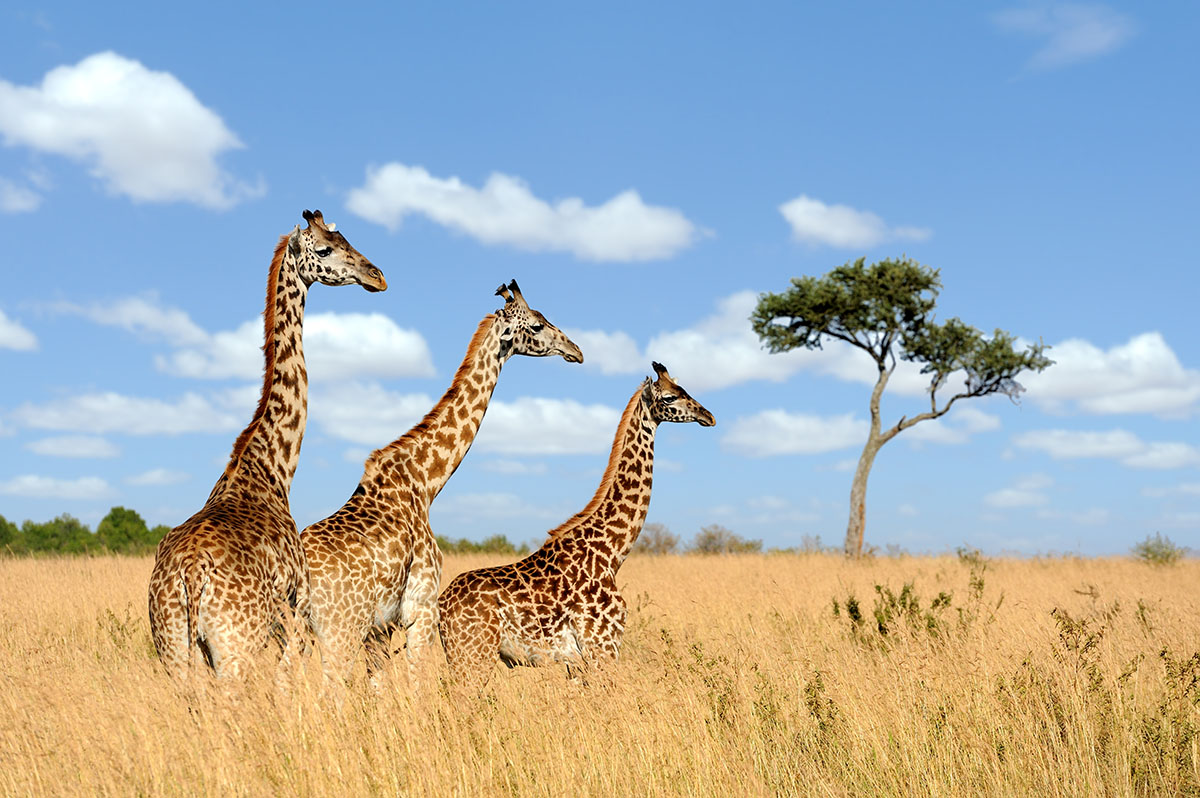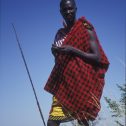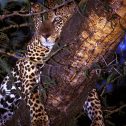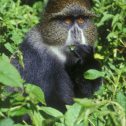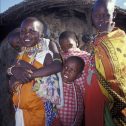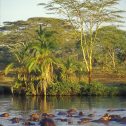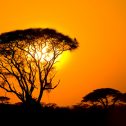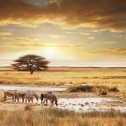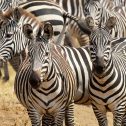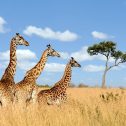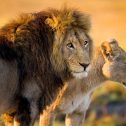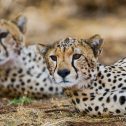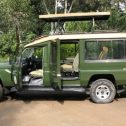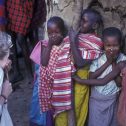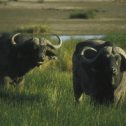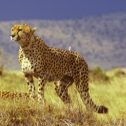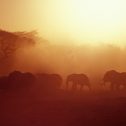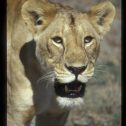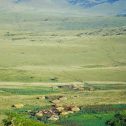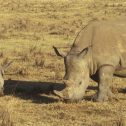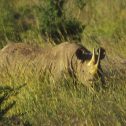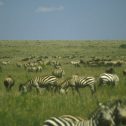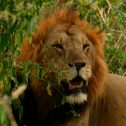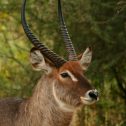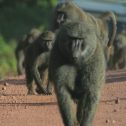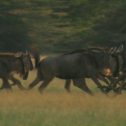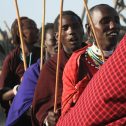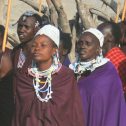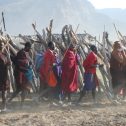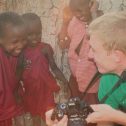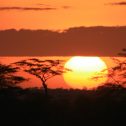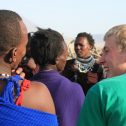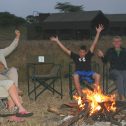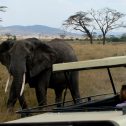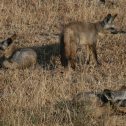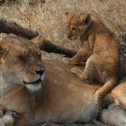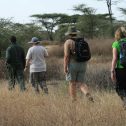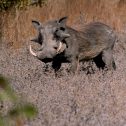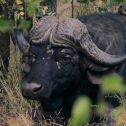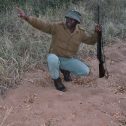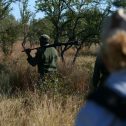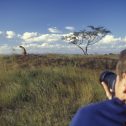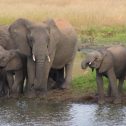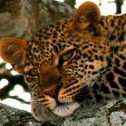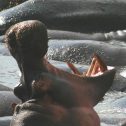Overview
This exciting overland adventure explores both the wildlife and cultural highlights of Tanzania, from the animal-rich boabab forests of Tarangire National Park to the awesome “land of the lost” splendor of Ngorongoro Crater, to the endless plains of Ndutu and the Serengeti…the people, landscapes and creatures will take your breath away!
- Feel the warmth of the African sun and the coolness of the morning breeze as you watch the sun rise over the Serengeti.
- Sense the vibration in your chest and the hair on your neck stand up from the deep-throated roar of a far off lion.
- Relax with a drink at a poolside overlooking a landscape full of wildlife.
- Listen as the Maasai drums pound out a rhythm as ancient as the plains.
Go Get Lost Reviews
Join us on this trip-of-a-lifetime as we explore the exotic wilderness of East Africa for 8 days. This is a small group safari that explores both the wildlife and cultural highlights of Tanzania, with all accommodations in smaller wilderness lodges or luxury tented camps. We’ll be visiting some of the world’s most exciting wildlife destinations…including Tarangire National Park, the fabled “Lost Land” of Ngorongoro Crater, incredible Lake Ndutu wildlife area, and legendary Serengeti National Park. The variety of landscapes and animals in all of these parks are beyond belief! A land of plains, lakes and mountains, with a narrow, low-lying coastal belt, Tanzania is East Africa’s largest country and also one of its most diverse. Tanzania is home for more than 100 different ethnic groups, mostly of Bantu origin, each with its own language and customs.
Tanzania has one of the largest and wildest animal populations in the world. Wildebeest, monkey, antelope, lion, cheetah, crocodile, gazelle, and flamingo – you name them. Blessed with some of the world’s largest game reserves, the country also has one of the highest concentrations of elephant, buffalo, hippo, wild dog and chimpanzee. You’ll be astounded at the huge amount of wildlife we’ll encounter…close up and personal! Bring your cameras…and lots of memory!
We’ll be staying at a fascinating mix of safari camps…from game lodges situated in the wilderness to deluxe safari tents in the bush. All of your meals are included, as are exciting game drives and even a bush hike with local guides. Since this overland adventure crosses a huge swath of the African landscape, our transportation is of utmost importance. For this we’re using custom built 4 x 4 overland safari vehicles, with a maximum of only 6 people per vehicle, so there’s a window seat for each person and a pop-up roof for animal viewing. Each vehicle has a personal wildlife guide and driver.
Tour Dates & Pricing
Photo Gallery
Click the thumbnail to view larger image.
Itinerary
Day 1 - Arusha
Upon your arrival, you will be collected from the airport and transferred to your lodge in the lush forests around the town of Arusha. Arusha is the safari capital of Tanzania located at the foot of Mt. Meru, close to Mount Kilimanjaro, the Manyara, Tarangire and Ngorongoro National Parks. Built by the Germans as a center of colonial administration because of the temperate climate, Arusha is the perfect location to begin an overland safari in northern Tanzania. Tonight we'll have dinner in our lodge, followed by a pre-trip meeting around the fireplace in the lounge. Then it's off to bed, we start our safari adventure in the morning!
Day 2 - Arusha-Tarangire
Your safari begins after breakfast this morning. On our adventure we will be traveling overland crossing great swathes of the African plains and countryside, searching for the game herds and their ever-present predators. We'll be traveling in style with custom-built 4 x 4 safari vehicles that are capable of dealing with the sometimes rugged African landscape. These overland vehicles are the result of many years of safari experience and design and will allow us to get to the game in safety and comfort! They have ample room, and as we only put a maximum of 6 people in each vehicle, (occasionally 7 if we have a single in the front seat next to the ranger), everyone has a window seat! And of course we have our own drivers, who are also our private ranger-guides for the entire trip! The vehicles also have pop-up tops to allow everyone the chance to watch game, take unobstructed (but safe) photos, or just feel the wind in your face.
We'll make our way towards Tarangire National Park, where open grasslands, acacia trees and the Tarangire River paint the wild landscape. Tarangire is one of Tanzania's richest reserves, known for its huge elephant population and baobab trees. It forms the center of the annual migratory cycle that includes up to 3000 elephant, 25,000 wildebeest and 30,000 zebra. Its high elephant population imparts a rare chance to get up close to these gentle giants, and there’s always the possibility of glimpsing some predators slinking through the savannah. A variety of ecosystems exist within the park boundary, providing a diverse range of wildlife with 94 species of mammals and over 500 bird species recorded.
In fact, after the Serengeti, Tarangire has the greatest concentration of wildlife in Tanzania and in the dry season the Tarangire River is a magnet for thirsty wildlife. Large herds of elephants and migratory wildebeest, zebra, buffalo, impala, gazelle, hartebeest and eland gather and not surprisingly the predators follow. This is also the one place in Tanzania where dry-country antelope such as oryx and gerenuk are regularly spotted. Tarangire is also known for its spectacular baobab trees, and its breathtaking views of the Maasai Steppe and the mountains to the south.
We'll spend the day in search of the animals, especially the large elephant population. Your trained guide shares exciting experiences and information about culture, fauna and flora as well as wild animals.
After our safari we'll find our way to our wilderness camp, where we'll spend the night in quintessential safari bungalows. If you’ve never experienced a safari lodge camp, you’re in for a true safari experience…with style! Tonight we can enjoy drinks in the dining room before sitting down to yet another outstanding African dinner. You’ll find the cuisine to be as impressive as the accommodations, too. Later tonight you might enjoy a drink on the veranda as you review all of your stunning photos.
Day 3 - Tarangire
Today, enjoy a game drive and an optional bush walk safari with a local ranger. Being on foot in the wild can be one of the most exhilarating and exciting things you'll every do. Hiking through the bush, along game trails and across the grasslands, at eye level with the animals...is an experience not to be missed. You may have opportunities to view the smallest creatures and maybe even the Big-Five...with all the safety your local bush guide can offer.
Your guides will also impart a wealth of knowledge about the habits of the animals, the different types of local vegetation, and how to effectively track some of Africa’s most impressive animals.
Tarangire National Park is known for the migratory movements towards the Tarangire River, which attract wildebeest, zebra, eland, red hartebeest, gazelle and buffalo. All of these may be spotted today while on foot…keep your eyes open, move stealthily, and follow your guide!
Day 4 - Ngorongoro Conservation Area
This morning after breakfast we'll leave Tarangire for a short drive northwest to the famed Ngorongoro Crater Conservation Area. This area includes the famous Crater and its lesser known regions to the north; the Olduvai Gorge (where Lucy was found in 1974) and expansive plains of grassland which run all the way across to the Serengeti. Local Maasai herd their cattle and goats alongside Africa's famed wildlife, as they have for centuries.
Ngorongoro itself is the world's largest inactive and intact volcanic crater, which was formed three million years ago. We’ll embark on a spectacular drive up the crater wall to the rim, then descend to the floor of the crater to spend the day exploring this magnificent wildlife sanctuary. Being one of the largest calderas in the world, 12.4 miles wide and almost 2,000 feet tall, with a variety of animals and vegetation, Ngorongoro Crater is one of Tanzania’s most stunning areas. The vegetation includes grasslands, swamps, forests, salt-pans, as well as a freshwater lake and has been compared to Noah's Ark or the Garden of Eden. With 20,000 grazing mammals and the world’s largest concentration of predators, you will have no trouble finding lion, elephant, buffalo and many of the plains herbivores such as wildebeest, Thomson's gazelle, zebra and reedbuck, as well as thousands of flamingo wading in the shallows of Lake Magadi, the soda lake on the floor of the crater. If you're lucky you'll have a black rhino sighting, which is an absolute rarity elsewhere in this country. Within the steep walls of the crater not only will you find considerable movement of animals, but you may well come across local Maasai tribesmen (who have grazing rights here), tending their cattle.
This afternoon, after a picnic lunch in the crater near the hippo pool, we leave the crater and drive up the winding caldera wall road and return to our lodge.
Day 5 - Lake Eyasi
Early morning we'll depart to Lake Eyasi for local hunting experience with the nomadic hunter-gatherer Hadzabe and Datonga tribes. With an estimated population of fewer than 2,000 individuals, the Hadzabe are one of the last tribes to stay true to their tribal history. The skills they will demonstrate are not a mere performance. The bushmen rely on these techniques to survive and you’ll need to be very attentive and at times quiet, while they demonstrate their use of locally made poisons in incapacitating the creatures on which they depend for survival. The tribe inhabits the shores of Lake Eyasi as do the Nilotic-speaking Datoga tribe, who are predominantly semi-nomadic pastoralists grazing cattle, goats, and sheep. During your visit to their homesteads, you'll learn about their way of life, animal tracking, medicinal plants, and much more. Some wildlife and a wide range of bird species can be viewed during walks around the lake, which can be arranged.
Tonight we return to our comfortable lodge for dinner and relaxation.
Day 6 - Ndutu
Ndutu is situated in the northern part of the Ngorongoro Conservation Area within the magnificent Serengeti. Lake Ndutu forms a shallow basin where water accumulates from the nearby areas of slightly higher altitude. The water in the lake is extremely saline, too saline for human consumption, but Lake Ndutu becomes alive with animals during the migration because it is surrounded by the Ndutu woodlands and the Short Grass Plains, which provide ample cover and food. From November to May, vast migratory herds visit the Ndutu area and provide a feast for the resident predators. Huge numbers of migratory birds come to the plains to feed and to escape the cold European winter. The lakes attract flocks of flamingos and other water birds. Animal viewing is excellent everywhere, as the surrounding landscapes are covered in sweeping grasslands which provide the perfect habitat for the migratory route for hundreds of thousands of wildebeest, antelope and zebra. Other commonly spotted species include: leopard, lion, cheetah, caracal, serval, African wildcat, and a variety of prolific birdlife.
This morning after breakfast we'll head out in our safari vehicles to explore the rich ecosystem of the area. We'll follow the migrations paths to the Southern Serengeti corridor where each year, around the same time, the circular great wildebeest migration begins in the Ngorongoro Conservation Area of the southern Serengeti in Tanzania. This migration is a natural phenomenon determined by the availability of grazing. This phase lasts from approximately January to March, when the calving season begins – a time when there is plenty of rain-ripened grass available for the 260,000 zebra that precede 1.7 million wildebeest and the following hundreds of thousands of other plains game, including around 470,000 gazelles. Danger is everywhere for these animals as packs of lion, cheetahs and other carnivores are roaming throughout the area, waiting for the right moment to strike...the scenes are amazing.
Tonight we'll stay in a true tented camp in the Ndutu-South Serengeti area, our base of operations for the next two nights. The stunning display of stars tonight combined with the sounds of the wilderness will be an experience you won't soon forget.
Day 7 - Ndutu - Serengeti
Today we'll immerse one more time into a full safari adventure, spotting lions and leopards and in this area as well as relatively easy-to-sight cheetahs, especially where there are large amounts of prey such as gazelle. Our game drive will lead us all over this region of the Serengeti National Park, which sprawls across 5,757 square miles, and is Tanzania’s largest and most famous national park. Most of the park is open swathes of grassland, broken by isolated granite kopjes (hills) and patches of acacia woodlands. Famous for its cheetah, Cape buffalo, and large herds of giraffe, the chief herbivore of Serengeti is the wildebeest of which there are up to two million. The amazing annual migration of wildebeest herds is one of the biggest attractions of the Serengeti. It begins November at the northern end of the Serengeti National Park near the Kenyan border, when huge herds of these animals cross into Tanzania from the Maasai Mara area in Kenya to head for greener pastures in the South Serengeti and Ndutu. By December they've arrived and begin feeding on the lush short-grass plains. Now the zebras reach their peak of foaling, and the wildebeest and gazelle also give birth to their young. It's a predator haven with an abundance of game animals seen no where else on earth. We’ll have a box lunch today to allow us to stay moving through the stunning landscape of endless plains, dotted with animal herds.
Tonight will find us back out our bush camp, enjoying a hearty dinner and a camp fire. The evening ends listening to the sounds of the wild, watching the sun go down and gazing at the never-ending sky.
Day 8 - Seronera
This morning we’ll enjoy a short game drive in the morning as we make our way to the small Seronera airstrip for our flight back to Kilimanjaro International Airport (JRO). Depending on the flight times, by late morning or early afternoon your flight will be landing, in plenty of time to catch your flight home, which typically depart in the evening.
CAMPS AND LODGES
Due to availability at the time of booking, camps and lodges listed may change to similar properties
Arusha - 4 Star Elewana Arusha Coffee Lodge: a welcome retreat after a long international flight. Take residence in one of 30 luxury wooden chalets - 12 Plantation Suites and 18 Plantation Rooms - nestled amongst the surrounding gardens and sea of coffee trees. Turning off the road, a tree-lined drive guides you to the warm and inviting main area with its quiet understated aura of luxury. Vibrant gardens, a spa, and a swimming pool await, and a restaurant, Bacchus, and café bistro, 3° South, boast menus to satisfy the most discerning of palates, successfully fusing international culinary prowess with locally-sourced ingredients.
Tarangire - Mbali Mbali Tented River Camp : If you are looking for an authentic safari experience under traditional canvas showcasing spacious views and enriching culture, Mbali Mbali Tarangire River Camp is the perfect choice. Set within a 25,000-hectare concession area, Mbali Mbali Tarangire River Camp is located 3.5 km from the main entrance of the Tarangire National Park, overlooking a branch of the Tarangire River itself. Traditional grass thatching adorns the roof of the main lodge structure, which is set off the ground on an elevated deck. The breezy lounge boasts ample seating in a relaxing open-air environment. The dining area, where culturally inspiring meals are served, consists of simple safari style seating and the elevated position allows for excellent views over the riverbank below. Both the dining and lounge areas are married into a proper bon-fire area and game viewing deck that also overlook the same stunning views. The lodge’s small, informal gift shop offers the families of the nearby Maasai villages a chance to sell some of their handmade wares. All safari tents are equipped with private verandahs and en-suite bathrooms with toilet, shower and basin. Each safari tent has been built on an elevated wooden platform allowing for the movement of wildlife through the lodge and hence decreasing the interference of the lodge presence on the ecosystem. Thatched roofs keep the tents cool even at midday.
OR
Tarangire - Burunge Tented Lodge: From the elegant wooden central platform where the Lake Burunge Tented Lodge restaurant stands, it’s possible to watch the lakeshore waiting for the animals that come to drink there. Because the camp is strategically located in the natural corridor between Manyara and Tarangire, so the spectacle of the migration is almost guaranteed. The camp is located 10 minutes from the entrance to Tarangire NP. This camp is the perfect place to relax in comfort after a day of game drives in Tarangire, simply carried away by the breeze and the colors of the African sunset from your private terrace.
Ngorongoro - Tloma Lodge: Tloma Lodge is a small, exclusive lodge situated on top of a valley overlooking a coffee plantation, the Eastern wall of the Ngorongoro crater and a beautiful waterfall. It consists of 36 spacious suites in cottages built in the style of an old colonial farm offering guests a relaxing, quiet atmosphere surrounded by beautiful gardens.
OR
Ngorongoro - Ngorongoro Farm House: Hand plaited thatched roof tops, ample verandas and colonial interiors at Ngorongoro Farm House, a small and exclusive lodge built on a 500 acre coffee plantation, all of which has been designed to take you to the comfort and style of past times. Take a walk around the farm to contemplate the daily activities, relax in the fragrant gardens or enjoy the spectacular sunsets with the Oldeani volcano as a backcloth. A wonderful stop-off during a safari on the north circuit of Tanzania and a privileged place from where one can visit the crater or enjoy activities such a walking safaris to the volcano or excursions to Lake Eyasi on the Rift Valley still inhabited by the Hadzabe tribe.
Ndutu-South Serengeti - Kati Kati Tented Camp: This is a semi-permanent campsite, which combines the comfort of a stable structure and the practicality of mobile camping. In fact the site can be moved seasonally according to the number of animals present, to the rains, and other natural surrounding elements. Situated in the south of Serengeti, with beautiful views to the African Savannah, the location is the perfect spot to enjoy the migration from December to April. The camp enables the guest to experience an authentic African safari and at the same time offering the perfect balance between comfort, intimacy and splendid isolation. The camp is tucked away in the bush, shaded by acacia trees, and is furnished in safari style with simple ensuite bathrooms, It's ecofriendly as it runs on solar lighting, and consists of ten double spacious fully furnished tents and one family tent. The camp completes its facilities with a mess tent where meals are served and a lounge tent. Here is the perfect base for you to indulge your passion for animal viewing and wildlife photography without missing out on your creature comforts. Apart from the massive presence of animals, the area has unforgettable and uncontaminated natural landscapes.
OR
Ndutu-South Serengeti - Suenos de Africa Luxury Camp: Sueños de África Luxury Camp is located right at the Heart of Serengeti’s wildebeest migrations (The 8th Wonder of the world) and home to the most dangerous animals in the World, “Hippos”. You can only reach their campsite any time before or after enjoying a fantastic day of safari. At Sueños de África Luxury Camp they work hard to make their customers feel immersed in the magic of the African Savanna from the first moment they arrive at the camp, so all their facilities are specially designed for their relaxation and well-being, basically; Wild Luxury Redefined.
What´s Included
- 1 night accomm at Elewana Coffee Lodge (or similar)
- 2 nights accomm at Mbali Mbali Tented Camp (or similar)
- 2 nights accomm at Ngorongoro Farm House Lodge (or similar)
- 2 night accomm at Ndutu Kati Kati Tented Camp (or similar)
- All meals
- Arrival airport transfers from Kilimanjaro International Airport (JRO)...Tour begins on Day 1 at Elawana Coffee Lodge near Arusha, and ends with the flight from Serengeti Seronera to JRO on Day 8
- All transfers during the tour, we use custom 4x4 overland safari vehicles. Size of vehicles is determined by group size. Every person has a window seat!
- Game drives in Tarangire National Park, Ngorongoro Conservation Area, Lake Ndutu Wildlife Area, and Serengeti National Park. We normally have about two game drives per day, depending on weather and logistics. Wild animal encounters are also common in and around many of our camps and lodges.
- Bush walk with ranger guides.
- Fully escorted by a local ranger-guides in each vehicle.
What´s not Included
- International airfare
- Alcoholic drinks
- Items of a personal nature...laundry, telephone calls, etc
- Early arrival package (accommodations, local tours).
- Gratuities to guides, drivers, or lodge staff
- Due to the remote nature of safari travel, Travel and Evacuation insurance is required for travel to Africa. Our office will email a quote to you when your initial deposit is processed.
- Visa fees, if necessary. A visa ($100) is required for U.S. visitors to Tanzania. It’s a fairly simple procedure, done at the airport upon arrival, or online in advance.
- Domestic flight from Seronera airstrip in Serengeti National Park to Kilimanjaro International airport on Day 8. Current price is $388. This is not included in your tour price, but will be billed on your final invoice.
- All National Park Fees, total of $844 per person. These are not included in the tour price, but will be billed on your final invoice.

